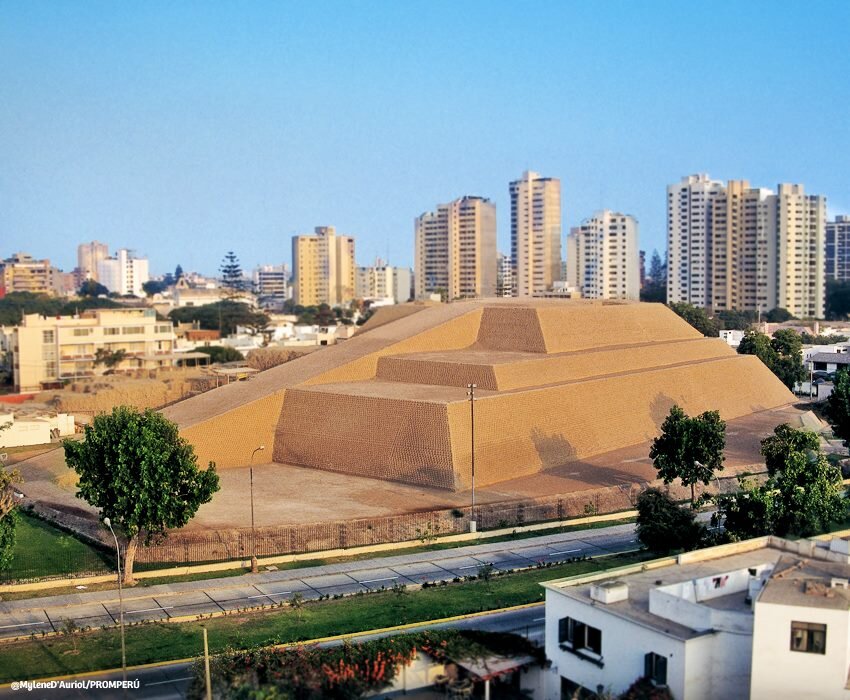The Huaca Huallamarca, formerly called Pan de Azúcar, is a pre-Hispanic construction in the shape of a truncated pyramid, located in the middle of the residential area of the San Isidro district, in Lima, Peru .
It was one of the main settlements of the Pinazo cultural tradition of the Peruvian central coast and its construction dates from approximately 200 BC. It became a cemetery in 300 AD, having burials corresponding to the Lima, Huaura (Tricolor-Geometric), Sicán, Chincha and Ychsma cultures .
In the 1950s it was rebuilt by the work of Arturo Jiménez Borja.
The name
Huallamarca was the name given to it by the Peruvian archaeologist Julio C. Tello in the 1930s . He called the entire area between the current districts of Lince and Miraflores "Wallamarka" or "Huallamarca" (town of the hualla in Quechua) since colonial chroniclers of the 16th century (published by Víctor Barriga) mention the existence of some "gualla lands" near where Huaca Pucllana is now in Miraflores. However, the name "Gualla" seems limited only to that site, so the name "Huallamarca" for the sanisidrina pyramid could be different. Until the beginning of the 20th century it was publicly known as "Sugar Loaf" from the shape of its adobes, which resemble a sweet known in Lima at that time.
History
The first information on Huallamarca corresponds to 1873, when Thomas Hutchinson, a businessman interested in culture, published his book Two years in Peru: with exploration of its antiquities . In which it presents the engraving of the archaeological site, being a stepped building on two levels with complete walls and a steep slope all around.
The first archaeological excavations were carried out in 1942 and were in charge of Julio C. Tello . The Peruvian archaeologist states that the Huaca Pan de Azúcar is part of the archaeological group called Wallamarca, which includes the Huaca Juliana, Lima-tambo and Santa Beatriz, as well as being within the limits of the Hacienda Pan de Azúcar (Tello 1999 (1942): 69).
In 1958, Arturo Jiménez Borja, together with Jorge Zegarra Galdós, excavated the top of the pyramid where a cemetery is located from which 48 funerary bundles were extracted, and which promoted the creation of the site museum, one of the first existing in Peru. Thanks to this, the Municipality of San Isidro managed to carry out conservation work with the intention of preserving the area from urban growth in the area.
In the field notebooks, Zegarra describes a large quantity of conical adobitos (corn grain) placed in disorderly rows around the huaca , showing that in the sectors where the conical adobitos courses are missing, the interior has been filled with gravel (Zegarra, 1958: 8). It should be noted that the use of amorphous adobes in its construction is typical of the Pinazo cultural tradition (years 100 BC to 200 AD) which were made by hand, keeping the imprint of the palms of the hands of Their creators. This detail allows us to establish that it was built before the Lima culture. It was developed in the valley (100-700 AD), the same that imposed another style of construction. Huallamarca was contemporary with other important Peruvian cultures such as the Vicus, Salinar, Topará (Paracas Necropolis ) culture , the Pucará culture , etc. The pyramid was later abandoned and was used extensively as a cemetery, until Inca times.
Between 1991 and 1992, three seasons of archaeological excavations were carried out by Lic. Clide Valladolid, within the framework of the Agreement for Research, Conservation and Enhancement of the Site, between the Municipality of San Isidro, the Museum of the Nation and the National Institute of Culture.
Restoration
In the 19th century it was visited by many travelers, as it was famous for its burials rich in ceramic and metal objects. According to ancient references, it was 125 m long by 76 m wide and its shape was conical, which is why it was called "Sugar Loaf".
In the 1920s a large cut was made in the flanks to enable a path to its top, which was leveled. In 1941 the municipality of San Isidro began its demolition, which was paralyzed due to the intervention of the National Archeology Board. In the 1950s, the Ministry of Development and Public Works authorized its demolition in order to erect a public park in its place, but as such disgrace did not prosper, the House of Culture of Peru began the revaluation and reconstruction of the pyramid, with the patronage of Carlos Neuhaus Rizo Patron, then mayor of the district. The restoration work was entrusted to Arturo Jiménez Borja, a doctor fond of archeology, who had already done similar work in Puruchuco . In 1960 The work was completed with the installation of a site museum that shelters the remains rescued in the place.
This huaca originally had the shape of a stepped pyramid. It is assumed that the enthusiasm of Jimenez Borja in the midst of the predicament of saving this ruin led to a creative restoration. Those who were present at the work usually affirm that on many occasions Dr. Jimenez Borja made excessive assumptions about the characteristics of the building.
Starting in 1991, Neuhaus Rizo Patrón, occupying the district's mayor's office for the second time, led to new investigations and cleaning works at the site, which were conducted by the archaeologist Clide María Valladolid.












